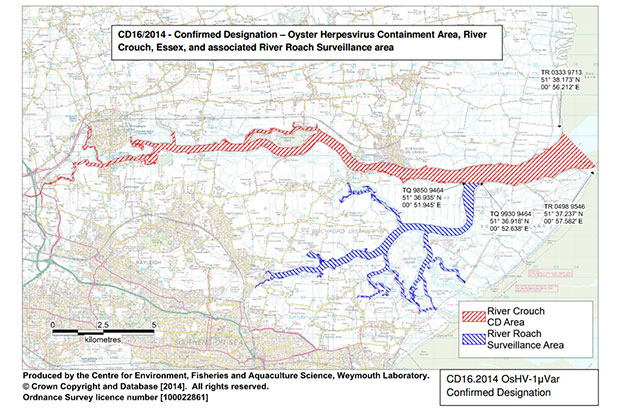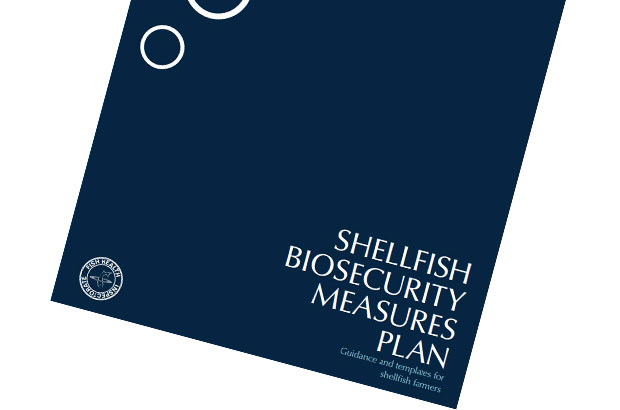Below is the background to the molluscan diseases that the Cefas Fish Health Inspectorate (FHI) regulated in 2014. The controls have evolved over several decades. And, to put them in context, their purpose is to allow the UK to trade freely with Europe and the rest of the world, whilst still offering protection to the health status of our farmed and wild shellfish.
We take the role seriously, and will always strive for the highest level of protection available to us as a nation. However it is vital for everyone to understand their individual role in disease prevention. It is actions on our beaches that will actually have the most impact in preventing the introduction and spread of diseases.
Listed Diseases
There are three categories of molluscan shellfish disease that the FHI are required to consider. The first two are known as “listed diseases”, as defined by EU legislation (Directive 2006/88). These are what the government has a statutory responsibility to monitor for:
- Exotic diseases – these are diseases not present in any part of Europe, and for which there are official controls that every country (member state) must apply in order to prevent their introduction into the European Union.
- Non-exotic diseases – these are diseases that are present in Europe, but are not considered widespread, and there may be member states (or parts of them) that are free from infection. There are official controls that apply to prevent the spread of these diseases from infected to uninfected areas.
The third category covers new and emerging diseases, which are not listed by the EU, but can sometimes develop into serious issues over time. An example being the recent emergence of oyster herpesvirus microvariant (OsHV-1 μVar).
There are mechanisms to allow the control of emerging diseases under EU rules, and currently the UK and the Republic of Ireland have approval to apply these additional controls for OsHV-1 μVar. But it can take some time to agree these official controls as they are agreed at European Commission level, which requires consensus between all member states.
The two sets of listed diseases are approved by the European Commission following agreement reached by representatives from each member state. This is the current list:
Exotic Diseases |
|
| Disease | Susceptible species |
| Bonamia exitiosa | Australian mud oyster (O. angasi) and Chilean flat oyster (O. chilensis) |
| Perkinsus marinus | Pacific oyster (C. gigas) and Eastern oyster (C. virginica) |
| Mikrocytos mackini | Pacific oyster (C. gigas), Eastern oyster (C. virginica), Olympia flat oyster (O. conchaphila) and European flat oyster (O. edulis) |
Non-Exotic Diseases |
|
| Disease | Susceptible species |
| Marteilia refringens | Australian mud oyster (O. angasi), Chilean flat oyster (O. chilensis), European flat oyster (O. edulis), Argentinian oyster (O. puelchana), blue mussel (M. edulis), and Mediterranean mussel (M. galloprovincialis) |
| Bonamia ostreae | Australian mud oyster (O. angasi), Chilean flat oyster (O. chilensis), Olympia flat oyster (O. conchaphila), Asiatic oyster (O. denselammellosa), European flat oyster (O. edulis) and Argentinian oyster (O. puelchana). |
Additional Controls |
|
| Disease | Susceptible Species |
| Oyster herpesvirus microvariant (OsHV-1 μVar) | Pacific oyster (C. gigas) |
However both the FHI - and you as shellfish farmers and harvesters - also need to consider a fourth category. This encompasses all the other diseases and infections that can be found in shellfish. And within this category are the diseases that we identify as a result of investigations into reported mortality events.
There are no official controls for these diseases, but they can still be of great significance to individual farms. So ensuring that you act responsibly and appropriately when moving stock between sea areas. As this is the only means of protecting your business against the potential economic losses that can result from disease.
Disease controls

When we identify and confirm one of the officially listed diseases above, disease controls are put in place to cover affected areas. These controls are the legal means which apply to infected areas in order to limit the spread of infection. Every operator in the affected area is responsible for complying with these rules.
When we are told about a mortality event, and if we suspect a listed diseases, an inspector will collect samples and issue an Initial Designation (ID). The ID provides the first restriction on movements of live shellfish to limit the potential spread of infection. If the disease is confirmed following the laboratory analysis of the samples taken, then the ID is replaced with a Confirmed Designation (CD), which specifies the controls that apply. The CD is made public on the GOV.UK website and all known stakeholders are notified.
However if the disease is not confirmed - and the mortality can be credited to other causes where statutory action is not required - then the ID would be lifted. These events are not formally made public. But mortality events are recorded in the annual national disease reports made to the Community Reference Laboratory.
Preventing new outbreaks
There are various ways in which disease causing organisms might be introduced to a new area. Shellfish can be infected with pathogens without showing any outward symptoms and so transfer of molluscs from an infected to a disease free area poses the greatest risk. This is why these movements are illegal from CDs for listed disease.
It is important to follow simple bio-security precautions. Ideally, do not bring in any shellfish from other areas. We know this is unavoidable for many farmers, so best practice is to check the sources carefully - not just the physical appearance of the shellfish but find out about the history of the stock. Also remember that there are rules that prohibit the deposit (putting into water) of oysters from infected areas. This includes tanks in on-shore facilities, even if only for temporary storage, as well as relaying.

The documented spread of disease in the UK and Ireland in recent years might easily have come about due to some of these actions, possibly carried out in ignorance of the controls. Therefore you should contact the FHI if you are in any doubt about the risks or suspect anyone of illegally depositing or discarding potentially infected shellfish in England and Wales. In Scotland it is the FHI, Marine Scotland, and in Northern Ireland it is DARDNI.
Other sensible precautions include ensuring that any water from depuration or storage tanks or from processing or washing shellfish is thoroughly disinfected before discharge. And that any unwanted shellfish are destroyed on land, well away from water. Working boats should be cleared of all shellfish and cleaned thoroughly by hosing down whenever work on or near a bed in an infected area is finished. They should not be washed down back at base. Using these precautions means everyone can play a part in preventing the introduction and spread of shellfish diseases.
Everyone in the shellfish industry, including fishermen, processors and merchants, as well as farmers, is urged to take great care to help prevent the spread of disease. Once introduced, diseases in shellfish farming areas are notoriously difficult to control. They will affect your business and your ability to trade with disease free areas in the UK, or within the EU.
For updates please sign up to email alerts from this blog, email me or you can follow us on Twitter @CefasGovUK.